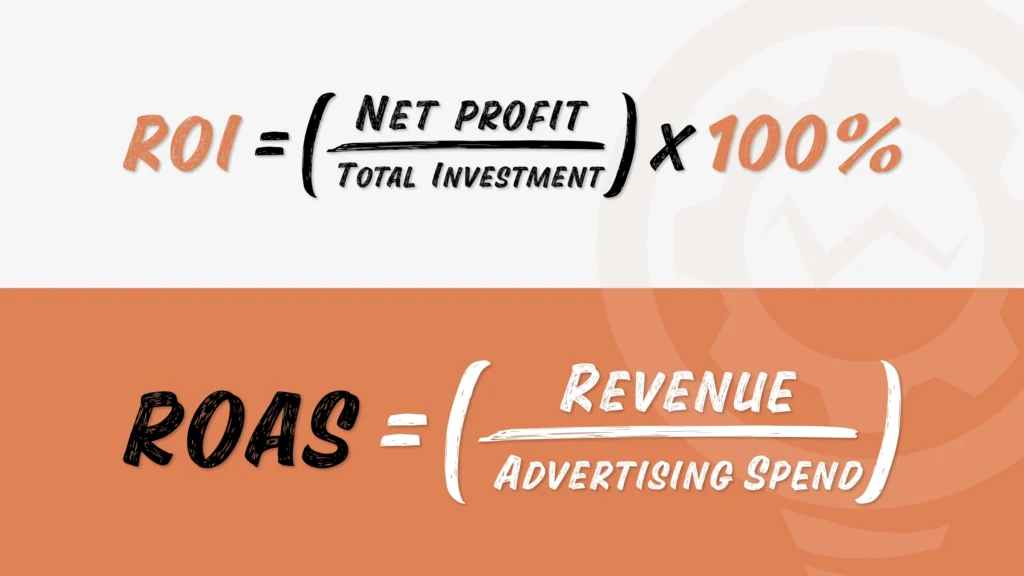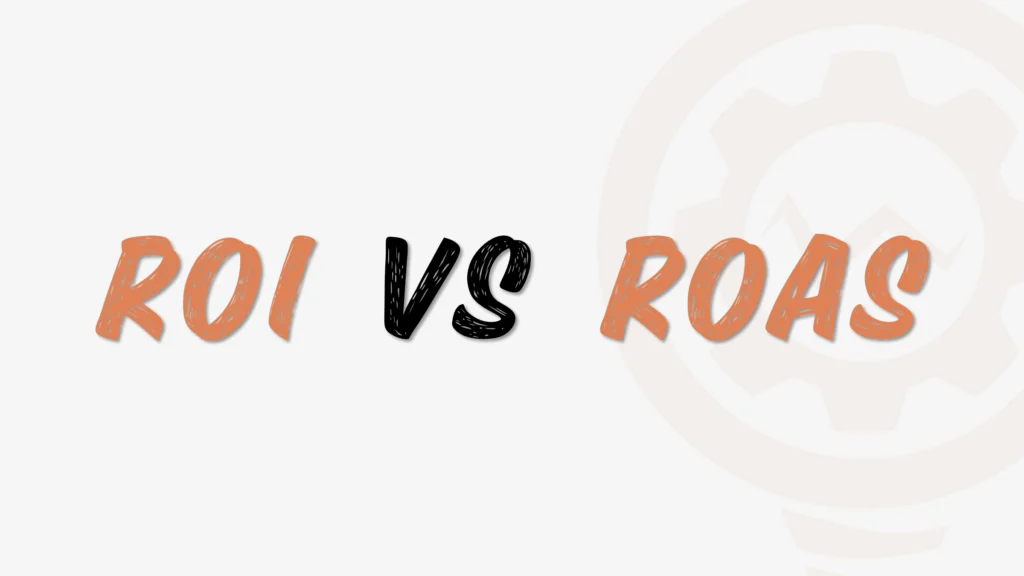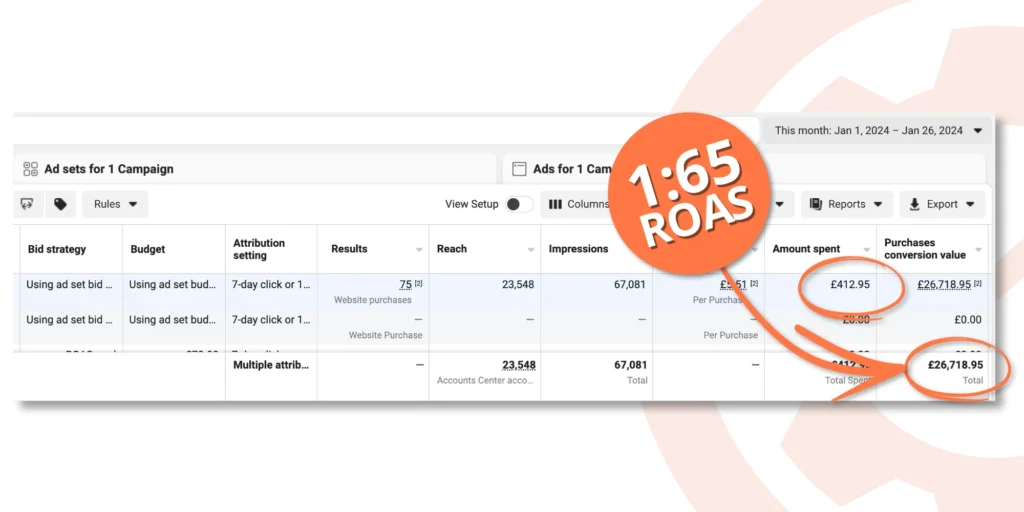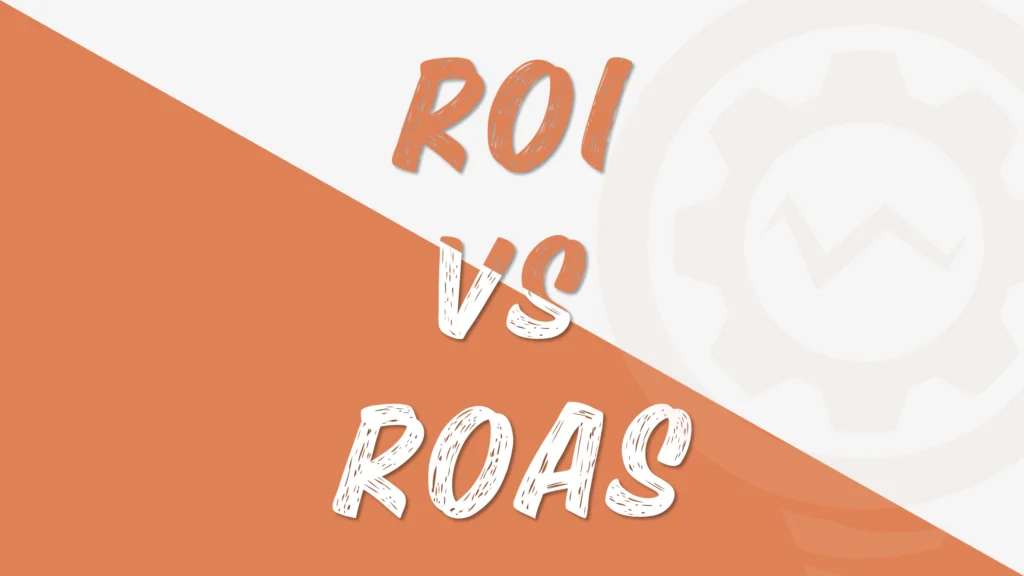
In our comprehensive exploration of maximizing marketing returns, we’ve navigated the intricacies of tracking ROI and demystified the complexities of ROAS. Now, in Part 3 of our series, we go deeper into the comparative analysis of ROI vs. ROAS. Join us as we analyze the nuanced differences, strategic implications, and practical applications of these key metrics to help you make informed decisions about your marketing efforts.
Table of Contents

Comparative Analysis: ROI vs. ROAS
While both ROI (Return on Investment) and ROAS (Return on Advertising Spend) are essential metrics for evaluating the effectiveness of marketing efforts, they differ in scope and application:
ROI (Return on Investment):
- Scope: ROI considers the overall profitability of an investment, taking into account all costs and revenue generated, not just advertising expenses.
- Calculation: ROI is calculated by dividing the net profit from an investment by the total investment cost and expressing the result as a percentage.
- Application: ROI provides a comprehensive view of the profitability of marketing campaigns and initiatives, including both advertising and non-advertising investments.
ROAS (Return on Advertising Spend):
- Scope: ROAS specifically measures the revenue generated from advertising expenditures, focusing solely on advertising effectiveness.
- Calculation: ROAS is calculated by dividing the revenue generated from advertising by the advertising spend and expressing the result as a ratio.
- Application: ROAS helps businesses assess the efficiency of their advertising campaigns and optimize advertising spend to maximize returns.
Key Similarities:
- Performance Metrics: Both ROI and ROAS are performance metrics used to evaluate the effectiveness of marketing investments.
- Financial Analysis: Both metrics provide valuable insights into the financial impact of marketing efforts, helping businesses make data-driven decisions.

Which Metric Should You Prioritize?
Deciding whether to prioritize ROI or ROAS depends on factors such as business objectives, marketing goals, and the specific context of each situation:
Prioritize ROI When:
- Considering Overall Profitability: If you need to evaluate the profitability of all investments, including advertising and non-advertising expenses, prioritize ROI.
- Assessing Long-Term Impact: If you want to measure the long-term financial impact of marketing campaigns and initiatives, ROI provides a more comprehensive view.
Prioritize ROAS When:
- Evaluating Advertising Effectiveness: If you specifically want to assess the revenue generated from advertising campaigns and optimize advertising spend, prioritize ROAS.
- Optimizing Short-Term Performance: If you’re focused on short-term performance and want to quickly identify which advertising campaigns are delivering the best returns, ROAS offers more immediate insights.
Consider Both Metrics:
- While ROI and ROAS serve different purposes, they are complementary metrics that can provide valuable insights when used together. Businesses can use ROI to assess overall profitability and ROAS to evaluate advertising effectiveness, allowing for a more holistic approach to performance measurement and optimization.
Ultimately, the decision to prioritize ROI or ROAS depends on your specific objectives, the scope of your analysis, and the insights you seek to gain from your marketing efforts. By understanding the differences and similarities between these metrics, businesses can make more informed decisions and optimize their marketing strategies effectively.
Complementary Roles: Leveraging Both Metrics for Success
ROI (Return on Investment) and ROAS (Return on Advertising Spend) each offer unique insights into the performance of marketing efforts, but they are most powerful when used together. Leveraging both metrics allows businesses to gain a comprehensive understanding of the financial impact of their marketing activities and optimize strategies for success.
Benefits of Leveraging Both Metrics
- Holistic Performance Evaluation: By combining ROI and ROAS, businesses can evaluate the overall financial impact of marketing activities while also assessing the effectiveness of advertising efforts. This comprehensive approach allows for more informed decision-making and better resource allocation.
- Optimized Resource Allocation: Analyzing both ROI and ROAS helps businesses identify high-performing marketing initiatives and advertising campaigns. By reallocating resources to initiatives with the highest ROI and ROAS, businesses can optimize performance and maximize returns on investment.
- Long-Term Strategic Planning: ROI provides insights into the long-term profitability of marketing efforts, while ROAS offers immediate feedback on advertising performance. By leveraging both metrics, businesses can develop long-term strategic plans that balance short-term performance with long-term profitability.

ROI and ROAS Case Studies – Success Stories from Shtrack
In our Case Studies section, you can read about the success stories and tangible results we’ve achieved for some of our esteemed clients. Our unwavering commitment is evident in our long-standing partnerships with our valued clients.
Meta Ads’ Outstanding 1:65 ROAS
Explore the extraordinary power of Meta Ads in this case study, where we achieved an extraordinary 1:65 return on ad spend (ROAS). See how we challenged conventional norms, meticulously optimized costs, and achieved unprecedented success for our client. Read the Meta Ads case study here.
16:1 ROAS with Google Ads
Discover the precision of our Google Ads expertise in this case study. We shattered industry norms by delivering an impressive 16:1 ROAS. With an investment of $7,740, we generated a remarkable $126,000 in revenue. Our strategic approach to PPC ensures that every advertising dollar spent translates into significant revenue, changing the landscape of digital advertising. Read the Google Ads case study here.
$98,838 in Organic Sales from SEO
Witness the transformative power of search engine optimization (SEO) in a space typically dominated by paid advertising. In this case study, our skilled SEO team achieved an approximate 6:1 ROI, resulting in an astounding $98,838 in organic sales on a budget of $17,150. Read the SEO case study here.
In each case study, we reveal the strategies, tactics, and insights that helped our clients achieve unprecedented success in their respective digital marketing efforts.
Maximizing Marketing Returns Through Effective ROI and ROAS Strategies
In today’s competitive business landscape, maximizing marketing returns is paramount for achieving sustainable growth and profitability. Implementing effective ROI (Return on Investment) and ROAS (Return on Advertising Spend) strategies is essential for optimizing marketing performance and driving measurable results.
Implementing Data-Driven Decision-Making
Data-driven decision-making lies at the heart of effective ROI and ROAS strategies. By leveraging data analytics and performance metrics, businesses can gain valuable insights into the effectiveness of their marketing initiatives and make informed decisions to optimize performance. Implementing data-driven decision-making involves:
- Utilizing advanced analytics tools to track and analyze key performance indicators (KPIs) such as ROI, ROAS, conversion rates, and customer acquisition costs.
- Conducting A/B testing and experimentation to identify high-performing strategies and refine marketing tactics based on data-driven insights.
- Using predictive analytics to forecast future trends and anticipate market dynamics, enabling proactive adjustments to marketing strategies.

Optimizing Marketing Budget Allocation
Optimizing marketing budget allocation is crucial for maximizing ROI and ROAS. By allocating resources strategically and prioritizing high-impact initiatives, businesses can optimize marketing spend and achieve better returns. Key strategies for optimizing budget allocation include:
- Conducting thorough market research to identify target audiences, market trends, and competitive landscapes.
- Implementing performance-based budgeting approaches that allocate resources to initiatives with the highest ROI and ROAS potential.
- Employing agile budgeting techniques that allow for reallocation of funds based on changing market conditions and performance metrics.
Continuous Monitoring and Adjustment
Continuous monitoring and adjustment are essential for maintaining agility and responsiveness in marketing strategies. By regularly tracking performance metrics and making timely adjustments, businesses can optimize ROI and ROAS and stay ahead of the competition. Continuous monitoring and adjustment involve:
- Setting up automated reporting systems to track KPIs in real-time and identify performance trends and anomalies.
- Conducting regular performance reviews and strategy meetings to assess marketing effectiveness and identify areas for improvement.
- Implementing agile methodologies such as scrum and kanban to facilitate rapid iterations and adjustments to marketing campaigns based on performance feedback.
Leveraging Tools and Technology for Enhanced Tracking
Leveraging tools and technology is critical for enhancing tracking capabilities and gaining deeper insights into marketing performance. By utilizing advanced analytics platforms, attribution models, and marketing automation tools, businesses can streamline tracking processes and improve ROI and ROAS measurement. Key tools and technologies for enhanced tracking include:
- Marketing analytics platforms such as Google Analytics, Adobe Analytics, and Salesforce Marketing Cloud for tracking and analyzing campaign performance.
- Multi-touch attribution models that provide a comprehensive view of customer journeys and attribute conversions to multiple touchpoints.
- Marketing automation tools for streamlining campaign management, lead nurturing, and customer engagement processes.
Implementing Strategies for Improved Returns
As you begin the process of implementing ROI and ROAS optimization strategies, consider the following next steps:
- Evaluate Current Practices: Assess your current marketing practices and identify areas for improvement in ROI and ROAS measurement.
- Develop Actionable Plans: Develop actionable plans to implement data-driven decision-making, optimize budget allocation, and enhance tracking capabilities.
- Leverage Resources and Expertise: Seek guidance from marketing professionals, leverage advanced analytics tools, and stay updated on industry best practices to maximize returns.
- Monitor Progress and Adapt: Continuously monitor performance metrics, analyze results, and adapt strategies based on insights to drive ongoing improvement.
By implementing these strategies and prioritizing ROI and ROAS optimization, your business can achieve greater efficiency, effectiveness, and profitability in its marketing endeavors.
In conclusion, ROI and ROAS optimization are integral components of a successful marketing strategy. By understanding these metrics, implementing effective strategies, and continuously refining your approach, your business can unlock its full potential and achieve sustainable growth in today’s dynamic marketplace.

Importance of ROI and ROAS in Demonstrating Marketing Effectiveness to Stakeholders
ROI and ROAS play a crucial role in demonstrating the effectiveness of marketing efforts to stakeholders, including executives, investors, and clients. By quantifying the financial impact of marketing activities and attributing revenue to specific initiatives, businesses can build credibility and secure support for future investments. The importance of ROI and ROAS in demonstrating marketing effectiveness to stakeholders includes:
- Providing tangible evidence of marketing ROI and ROAS to justify marketing investments and secure budget allocations.
- Communicating performance metrics in clear, concise, and actionable terms to stakeholders, highlighting the value generated by marketing initiatives.
- Building trust and confidence among stakeholders by demonstrating a strong understanding of financial metrics and a commitment to maximizing returns on marketing investments.
In conclusion, maximizing marketing returns through effective ROI and ROAS strategies requires a combination of data-driven decision-making, optimized budget allocation, continuous monitoring and adjustment, and leveraging tools and technology for enhanced tracking. By prioritizing ROI and ROAS measurement and demonstrating marketing effectiveness to stakeholders, businesses can achieve sustainable growth and drive measurable results in today’s competitive marketplace.

Conclusion
Recap of Key Points
- Understanding ROI and ROAS: ROI measures the overall profitability of investments, while ROAS focuses specifically on the revenue generated from advertising expenditures.
- Comparing ROI and ROAS: While both metrics serve distinct purposes, they are complementary and offer valuable insights into marketing effectiveness.
- Strategies for Maximizing ROI and ROAS: Implementing data-driven decision-making, optimizing budget allocation, continuous monitoring and adjustment, and leveraging tools and technology are essential strategies for maximizing ROI and ROAS.
- Importance of Stakeholder Communication: Demonstrating the effectiveness of marketing efforts to stakeholders through ROI and ROAS measurement builds credibility and secures support for future investments.
Maximize Your Marketing Returns: Partner with Shtrack for Financial Growth
Our agency specializes in helping businesses like yours optimize their marketing efforts and achieve maximum ROI and ROAS. We offer a range of consultation services tailored to your specific needs, including:
- ROI and ROAS Analysis: We’ll assess your current marketing strategies and provide actionable insights for improving ROI and ROAS.
- Campaign Optimization: Our experts will optimize your advertising campaigns to maximize returns and drive measurable results.
- Analytics Implementation: We’ll help you set up advanced analytics tools and tracking systems to accurately measure ROI and ROAS.
- Strategic Planning: Our team will work with you to develop data-driven marketing strategies that prioritize ROI and ROAS optimization.
Book a meeting with us. No strings attached.
15 minutes with our experts.

Enjoyed the article?
Elevate your business with our expert insights. Subscribe for valuable tips that make a difference!